 for a Successful Change Management Plan" width="100%" />
for a Successful Change Management Plan" width="100%" /> for a Successful Change Management Plan" width="100%" />
for a Successful Change Management Plan" width="100%" />
Flicking through articles on my tablet, I came across a study conducted by McKinsey and Company, creating an aha moment when thinking about the term business change.
The study looked at 2000 executives from 900 companies across multiple industries. More than half of respondents stated that, in five years, their change efforts failed to meet business goals and sustained results over time.
We at Process Street wanted to know why?
Trying to navigate business change without a formal process is like plonking an elephant into a china shop…
It can get messy.
What you need is a change management plan, to bring structure and control to the change process. If you ignore change – whether that be external to your business, internal, expected, or unexpected – or fail to respond appropriately, then there can be shattering negative consequences.
With our 9 free change management plan templates, you can effectively guide your business through change. These templates are just what you need to succeed in an ever-changing business landscape.
Scroll down to find out what a change management plan is and why it is needed, before moving onto our top 9 free change management plan templates. Alternatively, you can use the links below to jump to your section of choice.
Let’s get started!
A change management plan is exactly what it says on the tin, it is a plan for change. The plan defines activities and roles for the management and control of change. Planning for change maintains the change schedule, budget, scope, communication, and resources at a feasible and achievable level. It is an internal response to expected or unexpected change, that mitigates potential negative repercussions.
Change management is predominantly people focussed, it uses tools and techniques to manage the people side of change for a required business outcome.
Little is a given in business, what is certain though is change.
There are two types of change: Unexpected and intentional .
As the saying goes, if you are not prepared, then prepare to fail. When it comes to change, regardless of whether that change is intentional or not, an effective change management plan is needed.
Change has the power to crumble even the most successful companies if not planned for and managed appropriately.
It is often the case that the issue is not an inability to act, but an inability to take appropriate action. The term used is active inertia.
That is, through behavioral stubbornness, companies will continue along a set trajectory. Certain modes of thinking and actions have established success in the past and are inappropriately applied to the changing circumstances.
Under a false illusion, corporations continue without change in the face of change.
A paradoxical situation .
Active inertia may seem an innocent cognition, however, it can ripple devastating blows to a company’s success.

Ah, Kodak…the gold-standard example of what happens when companies fail to plan and respond appropriately to change.
I have a faint memory of being dragged into the Kodak shop, waiting for hours as my parents decided to print the year’s backlog of photographs. Today, these photos are stored in albums, forgotten and gathering dust. The albums are a melancholic reminder of what happened to Kodak…
A business that regressed into dust, only to be resurfaced in memento of the embarrassing failure the brand would rather forget. For Kodak, technological advances reared an ugly head, leading to its demise.
Kodak’s core business model was selling film. As cameras became digital and slowly disappeared into cellphones, images moved from print to online cloud storage.
Blinded by its previous success, active inertia meant Kodak completely missed the rise of digital photography.
But wait, there is more to this story.
In 1975, Steve Sasson, an engineer working for Kodak developed the first digital camera prototype.
The camera was large, cumbersome, and took ~20 seconds to take a picture.
Who would want that?
But this prototype signified a beginning of a transition. A transition that would make film and Kodak’s core business model superfluous.
Driven by an unwillingness to adapt and change, management’s response to Sasson’s development was…
“that’s cute – but don’t tell anyone about it”
The company filed for bankruptcy in 2012, exacted legacy business and sold off its patents.
Active inertia cost Kodak its success.
A change management plan prevents such common cognitions creeping in and causing a company’s demise.

The COVID-19 outbreak shook up our economy, imposing an uncontrollable external change, negatively impacting businesses both large and small at an unprecedented level. As nature took command, it truly was business-tooth-and-claw.
Adapt or fold. So how were businesses adapting?
One example would be the evolution of remote work.
As stated by Ryan Anderson from Bead the Change…
“Our company has started implementing remote work due to the recent stay at home orders“
Another example is the oil company Shell, stating:
“We are taking many steps to protect the health of our colleagues, including requiring or encouraging office-based staff to work from home, depending on the advice of local authorities. We are providing the technical support to ensure up to 70,000 people can work from home each day.” – Shell, COVID-19: Shell’s global response
I live in a small village in the mountains of North Wales, UK. Looking around I could see how the pandemic had affected small local businesses. Some closed up with the question arising: Will they re-open?
Others planned for and embraced change as an opportunity. They acted appropriately in light of the unexpected external change, remaining operational by adopting new ways to conduct business. For instance, restaurants continued to provide take-outs under social distancing rules. My local yoga teacher moved her lessons online.
Through adaption, these local businesses opened up new potential, investing, and exploring new ways of doing business. This diversification of business operations, in response to the COVID-19 outbreak, is a movement that can continue indefinitely to adapt and respond to change.
Change, in this sense, is embodied as a strength by taking appropriate action. A change management plan assists movement towards an appropriate action.
So far we have learned that change is unavoidable, and companies need systems in place to respond to change, whether that is internal, external, expected, or unexpected. A change management plan is an integral part of a change management system. A change management plan can bridge the difference between success in the face of change, and failure. Change management plans remove seemingly innocent cognitions such as active inertia.
This knowledge brings forward further questions:
The best way to adapt to and embody change is via the implementation of a change management model. A change management model is a properly structured and proven successful means of managing change.
Adapting to change is not easy – it takes time, effort, and energy. You want to make sure you stay in budget, on schedule, and that your invested change leads to a higher ROI.
You want to avoid clutching at thin-air, implementing random and irrelevant change action plans. You want and need to implement a change management model that is proven effective.
That’s why we at Process Street are going to show you how to implement the following 9 change management models:
Each one of these models has been adopted and transformed into a checklist format for easy implementation on your end. For instance, check out Lewin’s Change Management Model Process Checklist embedded below.
With this checklist, effort on your part is minimized. All you have to do is follow the steps, and you are guaranteed to plan for change in a way that is proven to be effective.
As promised, I present you with Process Street’s top 9 change management models, which you can implement for free today.
For simplicity and actionability, we have transferred these models into a checklist format. Open the checklist, follow each step with no second-guessing and no errors.
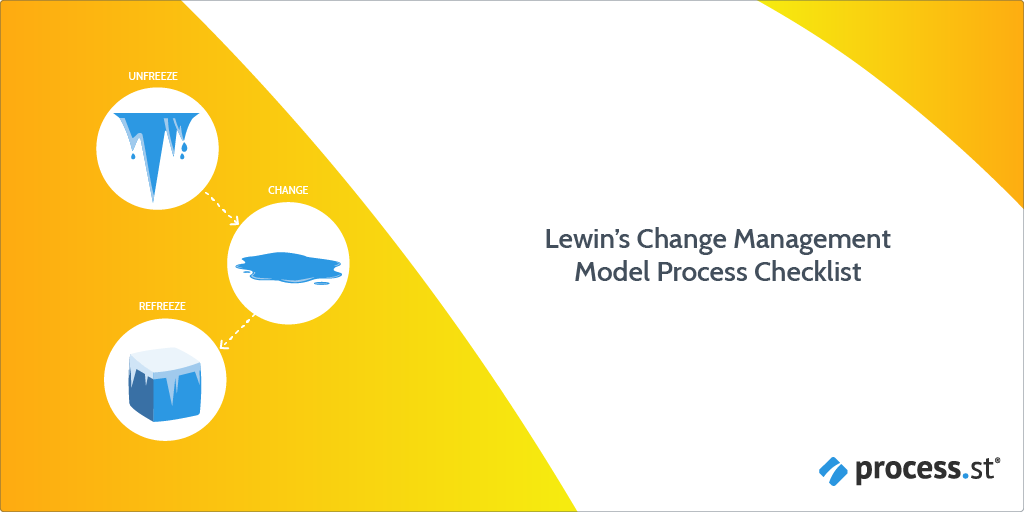
Developed by social psychologist Kurt Lewin in 1940, Lewin’s Change Management Model is one of the most popular approaches for dealing with and planning for change.
In this model, change is split into three stages:
Lewin’s model breaks change down into bitesize chunks, taking people, and processes into account. The model recognizes that companies can be stuck in a rigid process that needs to be unstuck for change to occur.
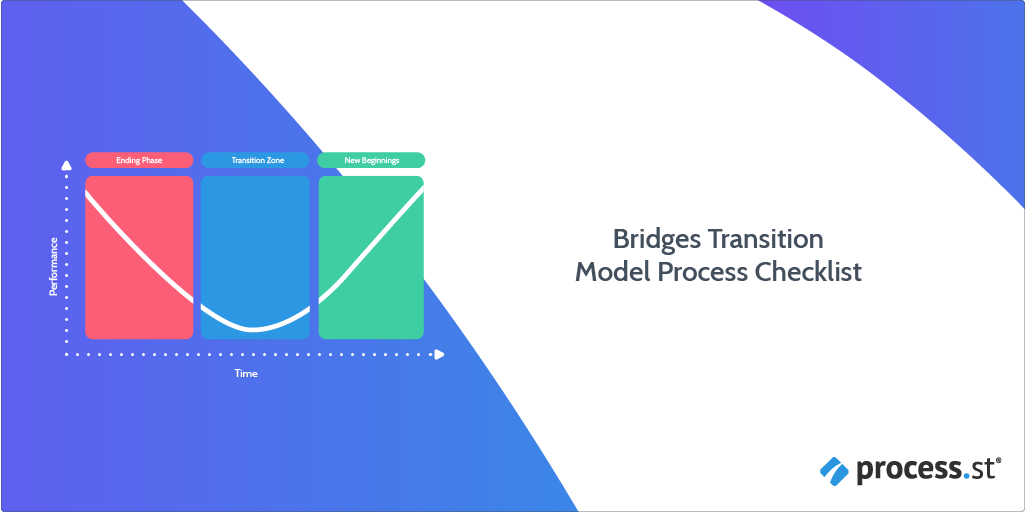
Developed by William Bridges in 1991, this model looks at change as a transition, considering the emotional journey of change experienced by the employees. In this model, the change is forced on the recipient, but this is acknowledged and dealt with.
The model considers the transition during change, looking at change as a journey instead of an abrupt shift. Three stages of this journey are detailed:
Each stage is characterized by the feelings instigated within the employee during that period.

Developed by Jeffery Hiatt in 2003, the ADKAR Model takes a bottom-up approach for the application of change. Each letter in the acronym stands for a goal to be reached:
With these goals, the ADKAR Model successfully plans for change on both an individual and organizational level. As a change management model, ADKAR is easy to learn, creates a new lens for viewing change, drives action, and addresses how change happens.

The McKinsey 7-S Model was developed in the 1980s by Robert H. Walterman and Tom Peters.
The model identifies 7 elements of a company, detailing how one will impact the other. These elements are split into two categories, hard and soft. Hard elements are driven by management and are more tangible. Soft elements are driven by culture and are less tangible.
Hard elements include:
Soft elements include:
The model aims to align these 7-S elements so that they support each other and your company’s objectives.
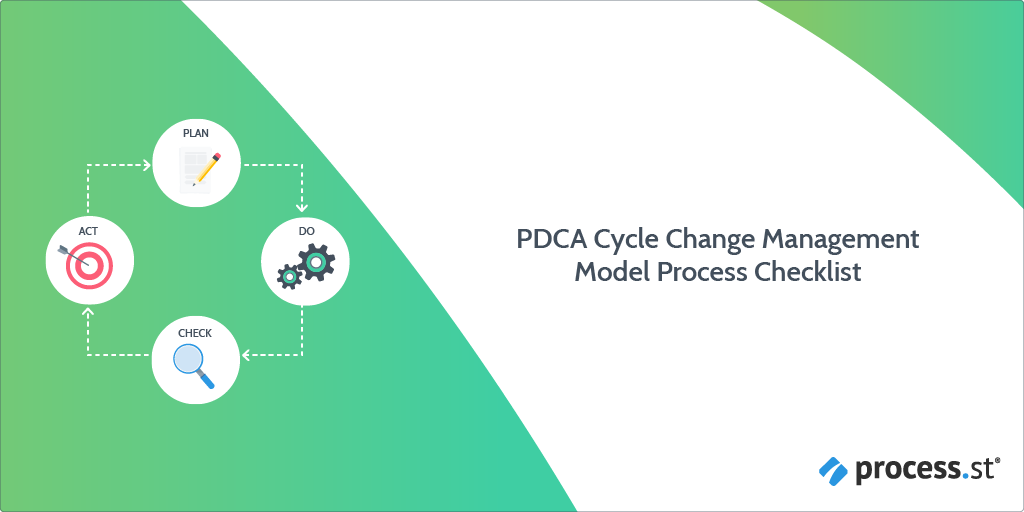
First introduced by Walter Shewhart, and later developed by W.Edwards Deming in the 1950s, the PDCA cycle looks at change as a continuous process for improvement.
There are four stages:
These stages are iterative, that is, as a circle, each stage is completed again, and again, and again…
Problems are identified, solutions are tested systematically, results are assessed and new solutions are implemented when needed.
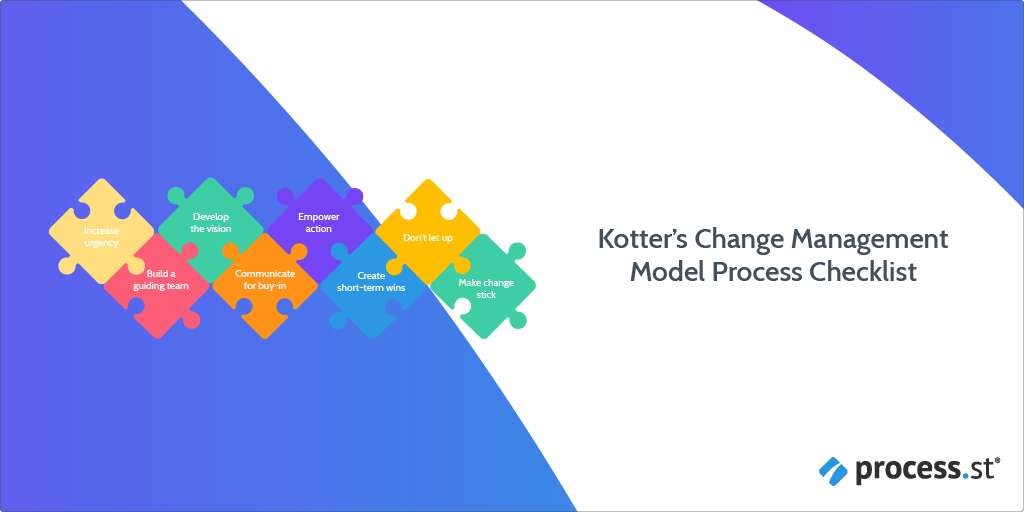
Developed by John Kotter in 1995, Kotter’s Change Management Model’s core focus is to create a sense of urgency for change. The model states, with this urgency, momentum for change is obtained.
The model splits the application of change into 8 stages:
The first stages are all about creating drive within your team to implement the needed change. The following stages focus on sustaining this drive, seeing the change through to the end.
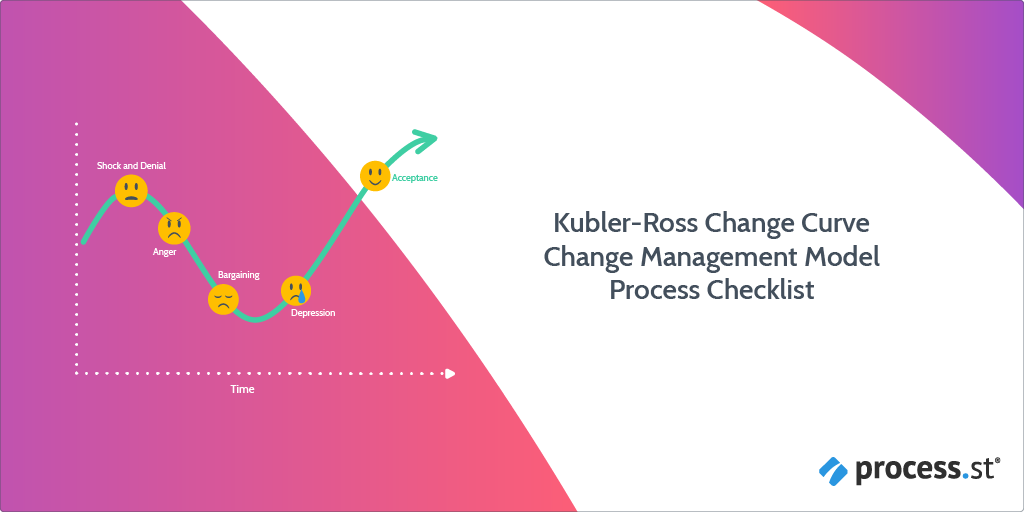
The Kubler-Ross Change Curve was developed by Elisabeth Kubler-Ross, a psychiatrist who detailed the first five stages of grief in her book On Death and Dying, published in 1969.
The model recognizes the emotional burden of change on employees within a company. These emotions can place a stranglehold on productivity. However, if acknowledged and managed correctly the negative emotional repercussions of change can be minimized.
The Kubler-Ross Change Curve details five stages of grief during the change process:
With knowledge of these stages, the model suggests a way to manage, control, and direct these emotions positively and progressively, leading the way for change.
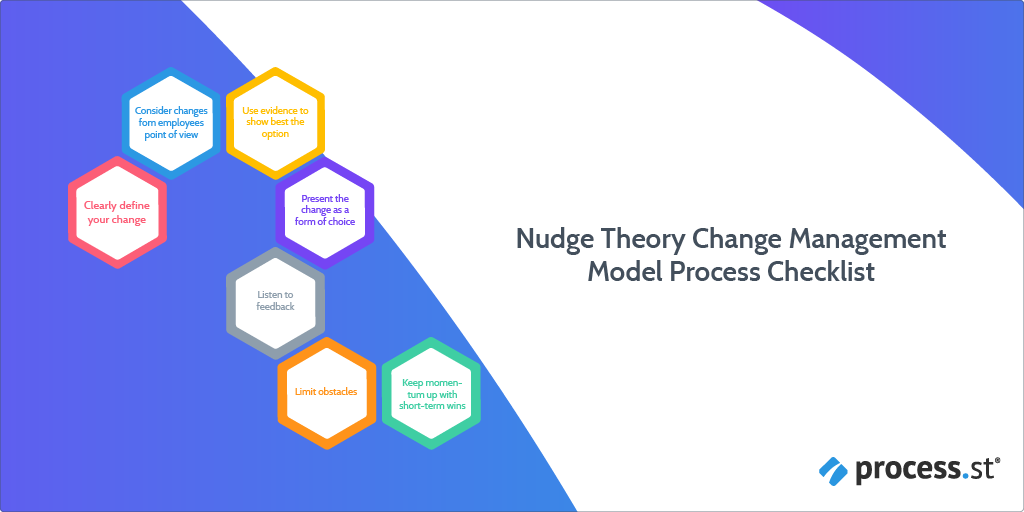
The Nudge Theory for change is more of a theory – hence the name – than a change management model. The idea is that individuals are nudged into making the desired decision by altering the environment in which the individual is making that decision. This environment is the choice architecture.
The theory is a behavioral science concept developed by Richard Thaler and Cass Sunstein in the book Nudge: Improving Decisions About Health, Wealth, and Happiness.
Individuals are nudged along the choice process with the end goal that they will choose your introduced changes. This Nudge Theory Change Management Model Process Checklist has been broken down into the following stages:
For more information on the Nudge Theory and Choice Architecture, read: Choice Architecture Explained: How To Remove Human Bias From Your Business Today
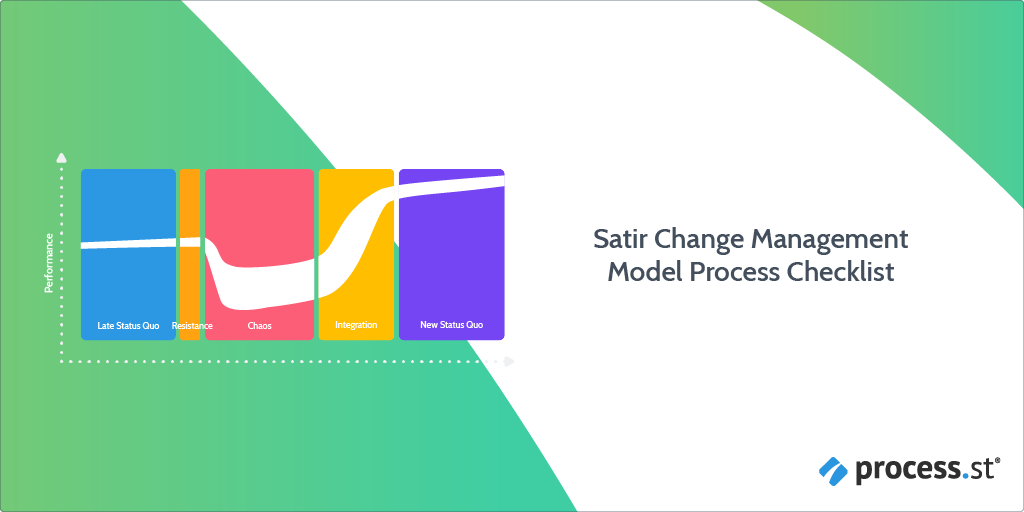
Developed by Virginia Satir, the Satir Change Management Model explores five stages of grief that employees are predicted to feel during organizational change.
These grief stages are:
The stages are designed to track the impact of change on employee performance.
If you are new to Process Street and unsure how to use our platform, watch the below webinar: An Introduction to Process Street.
Process Street is superpowered checklists.
Our 9 change management plan templates use a checklist format to guide you through the process of change implementation in your business. In these templates you will find the following features:
These features plus the ability to integrate with thousands of other products make your Process Street checklists superpowered!
You can edit any one of our change management plan templates to adapt the checklists to your specific needs. To find out more, watch the below video: The basics of creating and editing templates.
Change is an inevitable part of Business. We cannot stop it, but we can control potential negative aspects. Planning for change is key for positive progression, directing the impacts of change in your favor.
Kodak provides a stark reminder for us all of what happens when change is not adequately planned for and acted on. Luckily for us, there is a wealth of ongoing research into how change can be planned and managed more appropriately.
By transforming these top change management models into actionable checklists, we have made the planning and management of change easy for you. All you have to do is sign up for Process Street today to begin your change management journey.
For more information on how to manage change in your business, check out the following articles:
How do you plan for change in your business? What issues have you faced and how did you deal with them? We would love to hear from you. Who knows, you may get featured in an upcoming article!.